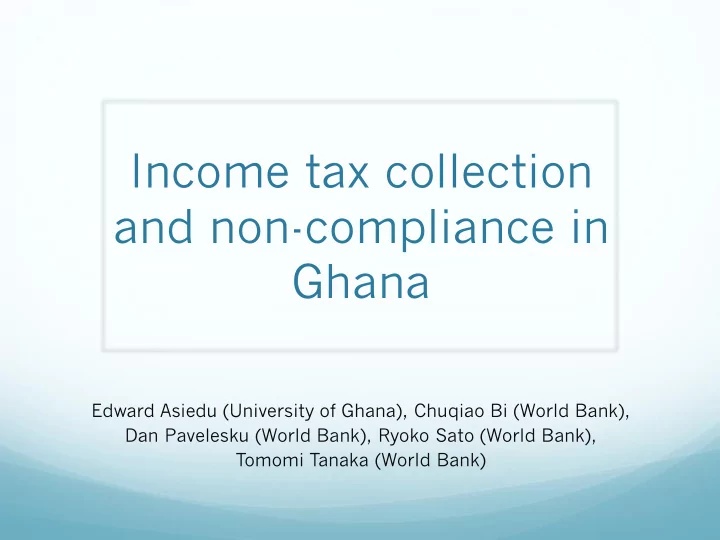

Income tax collection and non-compliance in Ghana Edward Asiedu (University of Ghana), Chuqiao Bi (World Bank), Dan Pavelesku (World Bank), Ryoko Sato (World Bank), Tomomi Tanaka (World Bank)
Objective To estimate potential income tax revenue gain from the enforcement of tax collection. Problems with Data Administrative income tax data: No information about workers who did not file income tax Household data suffers from under-sampling and under- reporting, especially high income individuals.
Comparison of income distributions between household survey data and administrative income tax data (2014) 0-1,980 Public sector 1,981-4,200 4,201-7,800 7,801-12,000 12,001-18,000 18,001-30,000 30,001-42,000 GLSS Income Tax data above 42,000 0 50,000 100,000 150,000 200,000 0-1,980 1,981-4,200 Private sector 4,201-7,800 7,801-12,000 12,001-18,000 18,001-30,000 30,001-42,000 GLSS Income Tax data above 42,000 0 50,000 100,000 150,000 200,000 250,000 300,000 350,000
Another problems with administrative income tax data Discrete -> need to produce continuous version of income distributions by simulations (Blachet, Founier and Piketty 2017) Comparison of income distributions between household survey data and simulation results (2014) 30 40 30 20 20 10 10 0 0 0 20 40 60 80 100 0 50 100 150 Income (1,000 GHC) Income (1,000 GHC) GLSS 6 Administrative Data (Simulation) GLSS 6 Administrative Data (Simulation)
Comparison of mean income between household survey data and simulation results (2014 and 2016) GLSS/LFS Simulation GLSS 6 - Public 7.92 14.78*** (0.23) (0.50) GLSS 6 - Private 7.53 13.15*** (0.30) (0.25) GLSS 6 - Total 7.69 13.96*** (0.19) (0.29) LFS - Public 15.25 16.79** (0.44) (0.49) LFS - Private 12.37 18.60*** (1.07) (1.77) LFS - Total 14.19 16.62*** (0.49) (0.61) � Comparison of the number of formal private sector workers between administrative income tax data and business census Admin data (2014) Admin data (2016) Business Census (2014) 1,145,183 309,763 1,417,368
Simulation results (2014) 0-1980 Public sector 1981-4200 4201-7800 7801-12000 Actual tax revenue 12001-18000 Simulation 18001-30000 30001-42000 above 42000 0 100 200 300 400 500 Millions Private sector 0-1980 1981-4200 Actual tax revenue Simulation I 4201-7800 Simulation II 7801-12000 12001-18000 18001-30000 30001-42000 above 42000 0 200 400 600 800 Millions
Changes in tax rate in 2016 Until 2015 Income Rate 0- 1,584 0 1,585-2,376 5 2,377-3,480 10 3,481-31,680 17.5 31,681 and above 25 From 2016 Income Rate 0- 2,592 0 2,593-3,888 5 3,889-5,700 10 5,701-38,880 17.5 38,881 and above 25 �
Simulation results (2016) Public sector 0-2,592 2,593-6,000 6,001-12,000 12,001-24,000 24,001-60,000 Actual tax revenue 60,001-120,000 Simulation I above 120,000 0 200 400 600 800 1,000 Millions Private sector 0-2,592 Actual tax revenue 2,593-6,000 Simulation I 6,001-12,000 Simulation II 12,001-24,000 Simulation III 24,001-60,000 60,001-120,000 above 120,000 Millions 0 500 1,000 1,500 2,000
Conclusion and Recommendations There is a large scale of non-compliance of income tax. ▪ Main cause in 2014: non or under payments in the public sector. ▪ Main cause in 2016: non-filing of PAYE in the private sector. If everyone paid income tax in full amount, tax revenue could have been higher by 1.2 billion Cedi (=1.4% of GDP) and 3 .6 billion Cedi (=2.2 % of GDP) in 2014 ad 2016, respectively. Data limitation Simulation results depend on the accuracy of 1) the number of workers in each income bracket, 2) mean income in each bracket, and 3) distribution of people who did not pay income tax. Ideal to use mean income from administrative income tax data. Policy recommendations Digitalization of tax records, linked to national ID. Enforcements of audit and penalty (proved to be effective in other countries).
Recommend
More recommend